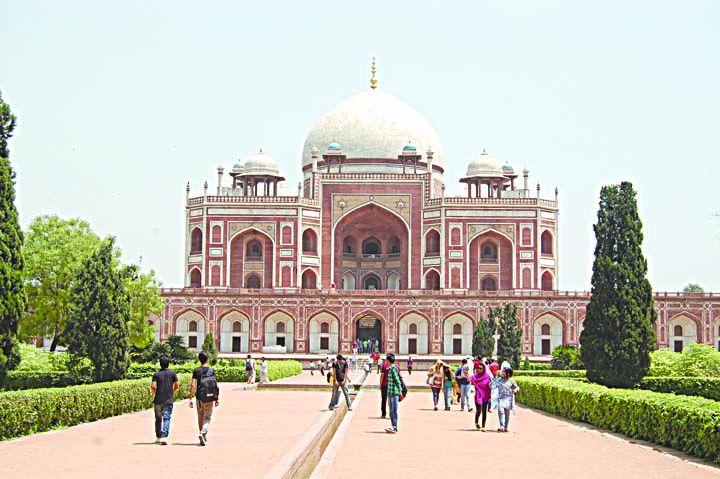Story & photos by Bernard Joseph Esposo Guerrero
In this second part of my India travelogue, I reminisce the joy and fulfillment in surveying a bit of India’s timeline prior to the British occupation through various religious and historic sites.

A glimpse of prehistory at the heart of the country
I arrived in my good friend’s hometown Bhopal, the capital of Madhya Pradesh, in time for my birthday, which coincides with the World Heritage Day. The city is surrounded by scenic lakes, and is a good base in exploring Central India. While the region is most notorious for its Kamasutra temples at Khajuraho, it is also home to the oldest-standing stone structures in the Subcontinent, the stupas at Sanchi, built in 300 BC by Emperor Ashoka.
Beyond temples, however, the region also features some of Asia’s oldest artworks. Braving the 45-degree-Celcius temperature outside, which is not unusual in this part of India, I went to the Ratapani Tiger Reserve not to visit the big cats, but to examine the rock shelters of Bhimbekta. In these ancient, natural dwellings, India’s early inhabitants left several paintings. Some of them are now 12,000 years, old, but still in very crisp conditions. These paintings depict various animals, some of which are already extinct, as well as portray humans performing religious rites, ritualized dances and even hunting. These prehistoric works of art are four times older than the Angono petroglyphs, the oldest in the Philippines.

Classical India and the rise of sacred cities
Religions started to flourish and societies became more complex in classical India. In Varanasi, considered as one of the world’s oldest continuously inhabited cities, my understanding of life and death came in full circle. It is the most sacred site in Hinduism and Jainism, and is an enduring portrait of how faith plays a crucial role in humanity. Every day, the river Ganges is flooded by pilgrims in what they consider as the ultimate act in professing their religious identities. Cremation of the remains of those who wished to be returned to the life-giving river is also a common scene in some ghats or riverfront steps. The evening Aarti pooja performance is also a sight to behold and is best viewed from the river on a boat. Together with a visit to nearby Sarnath, where the Buddha preached his first Dharma, going to Varanasi is a truly spiritual undertaking anyone should do in his or her lifetime.
An overnight journey aboard India’s highly efficient railway systems brought me next to Bodhgaya. In 623 BC on the site where the Mahabodhi Temple Complex now stands, Prince Siddhartha Gautama attained enlightenment under a Bodhi tree. This makes the site the holiest place related to the life of the Buddha and the “navel of the world” in the Buddhism worldview. Inside the temple complex, I fortunately gained the acquaintances of a local and a resident monk who enthusiastically showed me around, explaining some of the Buddha’s teachings. In my later trips, I would be seeing other Bodhi trees derived from the original one that became instrumental in spreading the faith down to Sri Lanka and as far as Indonesia.
Nearby Nalanda and Patna also enjoyed immense fame during their heydays, to the extent of having been mentioned by Greek and Chinese chroniclers. Patna’s beauty was once described to even rival that of Susa, the magnificent Persian capital.

Islamic conquest during the medieval period
More than a millennium later, India embraced another religion in an event that history would like to remember as “the meeting of two oceans.” The Islamic presence in India was cemented when the Qutb Minar complex in Delhi was constructed. The Qutb Minar, erected in 1192 to commemorate the Afghan conquest over the Rajputs, remains as the tallest brick tower in the world at 73 metres high.
The blossoming of Indo-Islamic architecture, however, came centuries later with the rise of the Mughals, gifting India and Pakistan some of their most invaluable jewels. The first appearance of a purely Mughal form was realized with Humayun’s tomb, also in Delhi. Built in the mid-1500s, it is also the earliest application of the Persian garden-tomb layout. Humayun’s tomb would later be considered as the grandfather of the more famous Taj Mahal. Agra’s Taj Mahal, commissioned by Shah Jahan, Humayun’s great grandson, is a masterpiece of human creative genius. Half a day admiring its architectural perfection and superlative beauty was not enough, but doing so convinced me well that the world would not have forgiven the British had their plan to demolish it pushed through during their rule. The formidable Agra fort, Delhi’s Red Fort, and the elegant Fatehpur Sikri are other Mughal period built-heritage not to be missed.
Mughal art also blended with vernacular styles. The synthesis of Rajput and Islamic Mughal traditions, for example, can be found in Rajasthan’s Amer Fort. This 17th-century palace represents an important stage in hill fortification architecture when purely defensive, rugged structures were already transforming into lavish, court-style residences of the Maharajas. Staying in the Pink City of Jaipur, 11 kilometres from Amer Fort, also allowed me to explore the Jantar Mantar, a medieval open-air astronomical observatory that stands as a testament to India’s brilliance in the sciences. Jaipur is also known for its outstanding town planning.
A country like no other
India is the birthplace of four world religions—the other is Sikhism—and has become a shining bastion of yet another one. As the cradle of one of the earliest known civilizations, it is not too difficult to understand why this country has such a rich history and a strong reputation echoed across the globe many times over.
Image credits: Bernard Joseph Esposo Guerrero



































